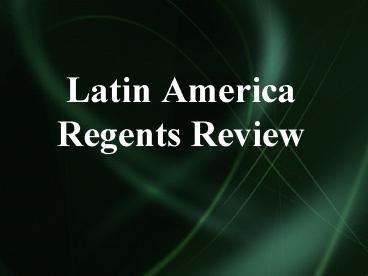Latin America Regents Review - PowerPoint PPT Presentation
1 / 36
Title:
Latin America Regents Review
Description:
Roosevelt Corollary (Big ... Economic Development Lack of industry Inflation Debt Payments Growing population Deforestation ... To supply the city with food, ... – PowerPoint PPT presentation
Number of Views:123
Avg rating:3.0/5.0
Title: Latin America Regents Review
1
Latin America Regents Review
2
4 Distinct Regions
- Mexico
- Central America
- South America
- Islands of the Caribbean
3
Topography
- Physical barriers limits unity.
- Andes mountains and Amazon river promote
regionalism.
4
Other Rivers
- Rio De La Plata
- Orinoco River
5
Climate
- Near Equator
- 3/4 lies in the Tropical Zone. Provide climate
for Rain forests. - Deforestation
- Tropical Savannas.
- Arid Lands (Deserts)
6
Natural Resources
- Topography makes farming difficult. Cash Crop
dependence. - Lacks natural resources for industrialization.
- Does possess oil, tin and silver.
7
Geographic Themes
- Barriers discourage unity and encourage
regionalism. - Diverse cultural development.
- Environmental issues.
- Overpopulation and cash crop dependency.
8
Indian Empires
- Mayan Empire (300 - 900)
- Polytheistic
- Religious rituals centered around the season.
- Writing and Math using concept of zero.
9
- Accurate calendar.
- Astronomical observatories.
- Great cities.
- Art and architecture.
10
Aztecs (1200 - 1521)
- Warrior society / rigid class structure.
- Conquered a huge empire.
- Used prisoners as slaves.
- Human sacrifices.
11
Inca Empire (1200 - 1535)
- Emperor descendent of sun god.
- Extensive road, building and engineering.
- Record keeping and measurement.
- Medical knowledge of surgery and disease.
12
European Exploration
- New trade routes to the East
- Mercantilist economic theory.
- Christian missionary.
- Treaty of Tordesillas
- Conquistadors
13
Mercantilism
- Provided raw materials for the mother country.
- Provided a market for finished goods.
- Mother country controlled a monopoly.
14
Encomienda System
- Large scale cultivation of cash crops (coffee,
sugar and tobacco). - Land grants and control of native labor.
- Slave labor extended to Africa.
15
Rigid Class Structure
- Peninsulares (Europeans)
- Creoles
- Mestizos and Mulattoes
- Native Americans and African Slaves
16
- A small privileged class controlled vast areas of
land and thus controlled its political and
economic power.
17
Role of the Catholic Church
- Established schools.
- Taught agriculture.
- Worked to end abuses
- The church eventually grew rich and gradually
supported the ruling elite, or upper class.
18
Independence Movements
- The Enlightenment, the American Revolution, and
the French Revolution. - Napoleons Impact
19
Independence Movements
- Toussaint-Louverture in Haiti
- Black Slaves in Haiti gained independence first
in Latin America - Louverture led a rebellion against French
plantation owners
20
Independence Movements
- Father Miguel Hidalgo in Mexico
21
Independence Movements (1803-1825)
- Simon Bolivar a.k.a. The Liberator. Led a
revolt against Spanish colonial rule. President
of Gran Columbia. - Jose De San Martin A professional soldier who
won independence for Argentina
22
- Bernardo OHiggins Chilean general who fought
with Martin to free Chile.
23
Failure of Representative Democracy
- Geographic barriers, border disputes, regional
rivalries and a lack of a democratic tradition
made political unification of all of Latin
America impossible. - Thus begins the rise of the Caudillos. (Porfirio
Diaz)
24
Post Colonial Latin America
- Economic and Social Inequality
- Catholic Church Conservatism
- The Monroe Doctrine
- Colonialism replaced by economic imperialism.
- Spanish American War
- Panama Canal.
25
20th Century Revolutions
- Mexican Revolution
- Fidel Castro Leader of Cubas communist
revolution. - Sandinistas Marxist revolutionary group.
- Contras U.S. supported rebels fighting the
Sandinistas.
26
Economic Evolution
- Haciendas Colonial agricultural system.
- Single Crop Economy
- Land Reform
- Nationalization Government take control of the
industries to keep the profits at home.
27
Identifications
- Salvador Allende Freely elected Marxist
president of Chile. - Fidel Castro Cuban revolutionary leader who
established a Marxist government.
28
- Daniel Ortega Leader of communist Nicaragua.
- Juan Peron Leader of Argentina, pursued
economic policy which led to inflation.
29
- Roosevelt Corollary (Big Stick) 1904 corollary
to the Monroe Doctrine. U.S. would exercise
international police power in Latin American
countries.
30
Identifications
- Monroe Doctrine Western Hemisphere closed to
further European colonization. - Good Neighbor Policy U.S. policy not to
interfere with internal dispute in L.A.
31
Identifications
- Organization of American States Promotion of
international cooperation and provide a peaceful
forum for regional disputes. 35 members
including the U.S.
32
- Bay of Pigs U.S. supported rebel invasion of
Cuba. - Alliance for Progress Instituted in 1961 and
later abandoned in 1974.
33
Communist Expansion
- Cuban Missile Crisis (1962)
- Overthrow of Allende (1973)
- Invasion of Grenada (1983)
- Support for El Salvador Contras (1980s)
- Expulsion of Cuba from the O.A.S.
34
War on Drugs
- General Manuel Noriega overthrown, arrested,
tried and convicted. - Peru fighting a guerilla war .
- U.S. cut off aid to government and increased fund
to other governments.
- Distribution of cocaine and marijuana.
- Latin American nations earn needed revenues from
sale of drugs. - Drug lords.
- Colombian cocaine brings in as much as coffee.
35
Economic Development
- Lack of industry
- Inflation
- Debt Payments
- Growing population
- Deforestation
36
Population Explosion
- 500 million people
- Improved public health
- Cultural values stress high birth rates and large
families.

